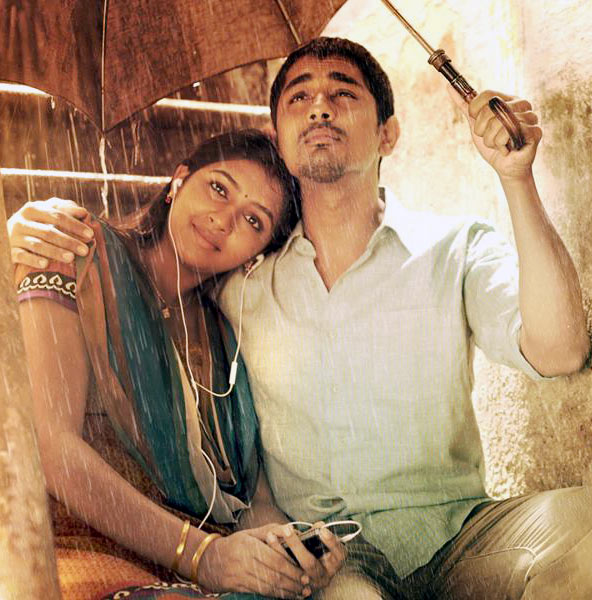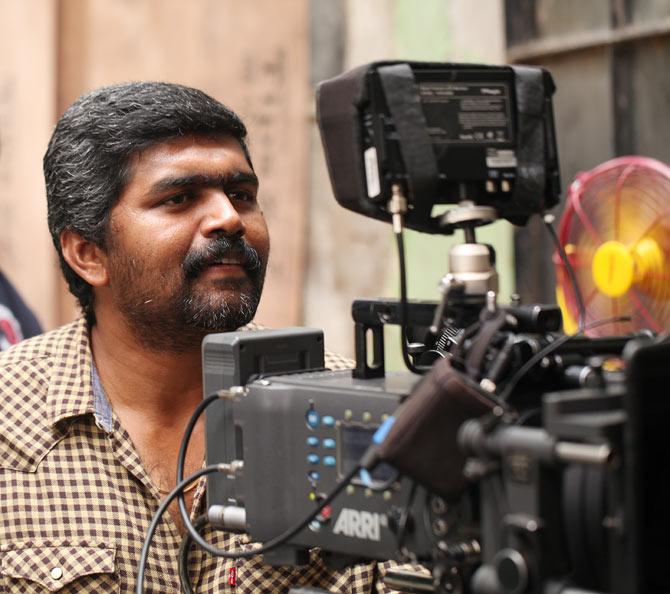 | « Back to article | Print this article |
'People are enjoying everything about Jigarthanda'
Gavemic U Ary, the cinematographer of Karthik Subbaraj’s Jigarthanda is a happy man. The film has been declared a hit and appreciation for his camera work has been pouring in from all quarters.
Gavemic who hails from Pondicherry has worked with cinematographers like Santosh Sivan, Jeeva and Guhan. He moved to Mumbai and shot several commercials before he made his debut with Akhilesh Jaiswal’s Mastram.
He talks to rediff.com about Karthik Subbaraj’s Jigarthanda.
Gavemic… your name arouses curiosity. What does it mean?
In Buddhism it means ‘The Emperor of the Sun Rise’.
You made your debut as a cinematographer in Hindi films with Akhilesh Jaiswal’s Mastram. Jigarthanda is your first film in Tamil. How did you meet the director, Karthik Subbaraj?
When I was working on Mastram, I heard the songs of the Tamil film Attakathi by Santosh Narayanan.
I thought it was brilliant. I contacted him and asked him to come to Mumbai and work on the background score for Mastram.
Santosh saw the film and loved my camera work. He suggested I work in a Tamil film and recommended me to Karthik Subbaraj. He told me that Subbaraj was a brilliant filmmaker and I must work with him.
I came down to Chennai and met Karthik and that was how it happened.
'We worked on the pre-production for about three months'
How did you go about planning in the pre-production?
We worked on the pre-production for about three months. On March 18, 2013, I landed in Chennai and we started filming on July 12.
Karthik gave me the bound script and it made an interesting read. It inspired me a lot. It is a musical gangster film and also a dark comedy.
We shot in and around Madurai. In the last many years, so many films in Tamil have been shot in and around Madurai that we had to show it differently.
It was the first time I was visiting that city. I have explored all possibilities to show it differently. Karthik was very clear that he wanted the cinematography to be on par with world cinema. We decided to shoot candid.
With regard to the locations, there is a perception that gangsters live in dark houses with no light. But if you look at Sethu’s (Bobby Simha) house, you will see a huge couch, a 42-inch LED television set. Gangsters are wealthy; they may not have a taste for interiors, but they want their material comforts.
Now, if you look at Oorni’s (Karnakaran) house you will see primary colors. You can observe a separation.
'Jigarthanda is a black comedy'
One scene in Jigarthanda that will always be remembered is the scene shot in the theatre’s toilet, where there is an attempt to kill Sethu. While Karthik’s writing and Simha’s performance nailed it, your contribution to that scene cannot be ignored.
We shot that in Balakrishna theatre in Porur. Initially, it wasn’t meant to be one long shot. If you notice carefully, the lighting pattern is very different in that one long shot.
In the canteen where Sethu and his men are joking around it is dark, and then Sethu gets up, goes to the cook to make small talk and you see a well-lit kitchen. Then he walks out in the rain towards the toilet where he meets the cleaner who suggests Sethu use the first bathroom and claims to have cleaned it exclusively for him.
I was very particular that the audience should not notice the cleaner’s face. We used patch lighting there. We shot that scene for an entire day.
I am really glad that audiences are enjoying the film and observing the minute details. I have been checking comments on Facebook and Twitter and it has been gratifying.
People are enjoying everything about Jigarthanda.
What are your future projects?
Talks are on, both for Tamil and Hindi films.


